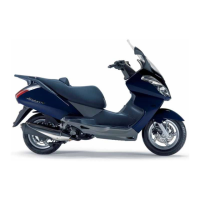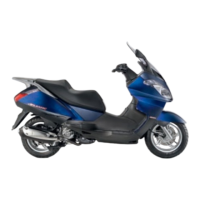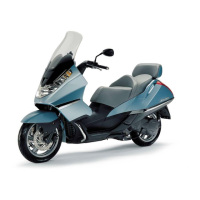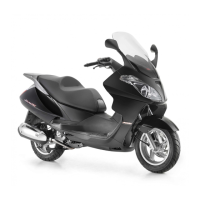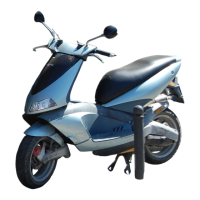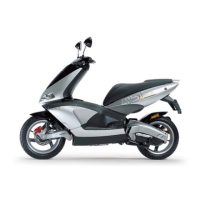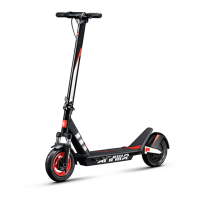Do you have a question about the APRILIA Atlantic 300 and is the answer not in the manual?
Essential safety guidelines for handling fuels, high-temperature components, and chemicals.
Information on chassis and engine numbers, vehicle dimensions, weight, and wheelbase.
Details on engine type, capacity, bore/stroke, compression, valve clearance, and transmission type.
Data on frame type, steering inclination, front suspension, rear suspensions, and trail.
Information on battery, alternator, bulbs, and brake system components.
Specifications for wheels, tyres, pressures, and torque values for various components.
List and descriptions of specialized tools required for vehicle maintenance and repair.
Table outlining recommended checks and replacements at specific mileage intervals.
Procedures for checking, cleaning, and replacing the spark plug and related ignition parts.
Checks for hub oil, engine oil, transmission oil, and air filter replacement procedures.
Procedures for checking coolant level, fan operation, and radiator service.
Instructions for checking brake fluid level, pads, and bleeding the hydraulic system.
Guidelines for adjusting front headlight beams horizontally and vertically for proper illumination.
Diagram showing the arrangement and numbering of key electrical components on the vehicle.
Details on main fuses, battery specifications, and operation of stop light and fan relays.
Information on CDI unit, diagnostics socket, water temperature sensor, and voltage regulator.
Details on HV coil, voltage regulator, start-up relay, and coolant temperature sensor.
Procedures for checking electrical components, sensors, and diagnosing common faults.
Step-by-step instructions for removing and refitting the exhaust system components.
Detailed process for removing the engine from the chassis and reinstalling it safely.
Procedures for servicing the transmission cover, clutch assembly, and drive belt.
Steps for splitting crankcase halves, inspecting crankshaft components, and reassembling.
Procedures for removing, inspecting, and refitting cylinder head, valves, and camshaft.
Instructions for oil pressure checks, oil pump, oil sump, and crankshaft oil seals.
Procedures for removing, inspecting, and refitting the flywheel, magneto, and starter motor.
Explanation of the integrated ignition and injection system, its components, and function.
Important safety precautions and common troubleshooting tips for injection system faults.
Details on ECU connector pinouts, EMS circuit diagrams, and troubleshooting strategies.
Common issues like engine not starting, rough idling, and poor performance with diagnostic causes.
Procedures for checking fuel pump, filter, injector, and pressure regulation.
Identification of front fork parts and procedures for wheel and fork service.
Guidelines for checking wheel axle, rim eccentricity, and tyre condition and pressure.
Procedure for checking and adjusting steering bearing clearance for proper handling.
Instructions for rear shock absorber inspection/adjustment and centre/side stand service.
Key for brake system parts and overall hydraulic circuit diagram.
Steps for removing, inspecting, and replacing brake discs and pads for optimal performance.
Detailed process for purging air from the hydraulic brake circuit to ensure proper function.
Instructions for changing brake fluid and checking reservoir levels for system integrity.
Procedures for checking, testing, and removing the electric cooling fan and its relay.
Steps for draining, removing, and refilling the radiator with coolant.
Procedures for removing and checking the thermostat and coolant temperature sensor.
Steps for removing the saddle, undertails, and helmet compartment for access.
Procedures for removing driving mirrors and handlebar covers for access or replacement.
Instructions for replacing instrument panel bulbs, clock battery, and checking the panel.
Procedures for replacing headlight and taillight bulbs and removing assemblies.
Steps for removing front and rear mudguards and the fuel tank assembly.
Detailed instructions for disassembling major chassis components and electrical connections.
Checks for paintwork, plastic parts, scratches, dirt, and fastener torques before delivery.
Verification of switches, lights, instruments, and starter system operation.
Procedures for charging the battery and checking various fluid levels.
Comprehensive checks of brakes, clutch, engine, documentation, and tyre pressure.
| Displacement | 278 cc |
|---|---|
| Fuel System | Electronic Fuel Injection |
| Starter | Electric |
| Transmission | Automatic CVT |
| Front Suspension | Telescopic fork |
| Front Tire | 120/70-14 |
| Seat Height | 790 mm |
| Engine Type | Single-cylinder, 4-stroke |
| Ignition | Electronic |
| Rear Suspension | Dual shock absorbers |
| Front Brake | Disc brake |
| Rear Brake | Disc brake |
| Max Power | 22.5 hp (16.5 kW) @ 7, 500 rpm |
